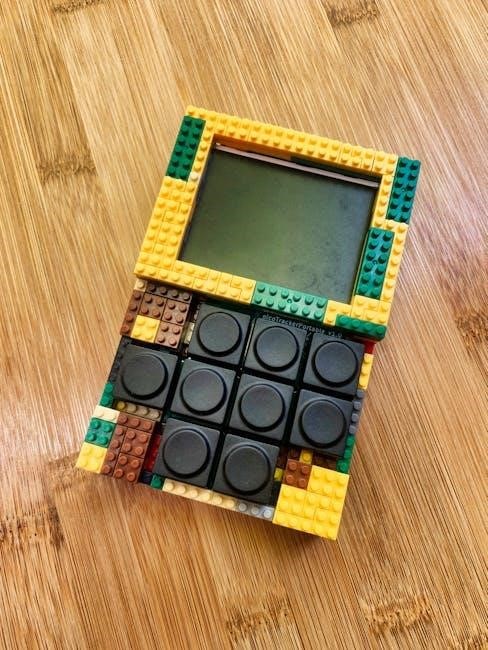Educational theories provide frameworks for understanding learning processes, shaping curriculum development, and informing teaching practices. They include behaviorism, cognitivism, constructivism, humanism, and connectivism, each offering unique perspectives on education.
Behaviorist Theory
Behaviorist theory focuses on observable behaviors, emphasizing conditioning and external stimuli. It discounts the mind’s role, linking learning to environmental factors and reinforcement techniques.
2.1. Key Concepts
Behaviorist theory centers on observable actions and discounts mental processes. Key concepts include classical conditioning, operant conditioning, and reinforcement. Classical conditioning involves associating stimuli to elicit responses, while operant conditioning focuses on behavior modification through rewards or punishments. Positive reinforcement increases desired behaviors, and negative reinforcement removes unpleasant stimuli to encourage actions. Punishment, either presenting something unpleasant or removing something pleasant, aims to reduce undesired actions. These mechanisms suggest that learning is shaped by external factors rather than internal thoughts or emotions, emphasizing the environment’s role in behavior development.
2.2. Major Theorists and Applications
Behaviorist theory is rooted in the works of B.F. Skinner, Ivan Pavlov, and John B. Watson. Skinner’s operant conditioning emphasizes rewards and punishments to shape behavior, widely applied in classrooms through token economies and behavior charts. Pavlov’s classical conditioning explains how stimuli can trigger responses, influencing techniques like associative learning. Watson’s focus on observable behavior laid the groundwork for structured teaching methods. Applications include systematic desensitization, conditioning techniques in special education, and the use of positive reinforcement in classroom management. These principles are foundational in applied behavior analysis (ABA) and instructional design.
Cognitive Theory
Cognitive theory focuses on mental processes like memory, problem-solving, and decision-making, emphasizing how learners actively construct knowledge. It highlights the role of understanding and organizing information in education.
3.1. Key Concepts
Cognitive theory emphasizes mental processes such as perception, memory, thinking, and problem-solving. It posits that learning occurs through active processing and organization of information. Key concepts include schemas, which are mental frameworks that help organize knowledge, and the idea that learners construct meaning through experiences. The theory also highlights the importance of prior knowledge in shaping new learning, as existing schemas influence how new information is interpreted and stored. Additionally, cognitive load theory suggests that managing the amount of mental effort during learning is crucial for effective understanding and retention of material.
3.2. Major Theorists and Applications
Key theorists in cognitive theory include Dale H. Schunk, who emphasized the role of thought processes in learning. Suzanne M. Wilson also contributed by linking cognitive theories to teacher education and curriculum design. Cognitive theory has been widely applied in education, particularly in designing structured learning environments that reduce cognitive load. Strategies like scaffolding and metacognitive training are commonly used to enhance understanding and retention. These approaches are integral to modern educational practices, emphasizing the active role of learners in constructing knowledge and solving problems effectively.

Constructivist Theory
Constructivist theory emphasizes learner-centered approaches, focusing on active experience and social interaction. It suggests that knowledge is constructed through personal experiences and collaborative environments, shaping understanding.
4.1. Key Concepts
Constructivist theory posits that learning is an active, iterative process where individuals construct knowledge through experience and social interaction. Key concepts include active learning, where learners engage in meaningful tasks, and the role of prior knowledge in shaping new understanding. Social constructivism, influenced by Vygotsky, emphasizes collaboration and dialogue, asserting that knowledge is co-constructed in cultural contexts. The theory also highlights the importance of scaffolding, where educators guide learners within their zone of proximal development. Ultimately, constructivism views knowledge as a dynamic, evolving construct rather than a fixed entity, fostering critical thinking and problem-solving skills in learners.
4.2. Major Theorists and Applications
Lev Vygotsky, a key constructivist theorist, introduced the concept of the zone of proximal development, emphasizing the role of social interaction in learning. Jean Piaget also contributed, with his theory of cognitive development through stages. In education, constructivist approaches are applied through problem-based learning, collaborative projects, and authentic assessments. These methods encourage active participation, critical thinking, and real-world application of knowledge. Constructivist principles are widely used in curriculum design, particularly in subjects like science and mathematics, where hands-on experimentation and peer discussion are valued. This approach fosters deeper understanding and prepares learners for complex, dynamic environments.
Humanistic Theory
Humanistic theory, led by Carl Rogers and Abraham Maslow, focuses on personal growth, self-actualization, and holistic development. It emphasizes emotional support and intrinsic motivation in education.
5.1. Key Concepts
Humanistic theory emphasizes personal growth, self-actualization, and intrinsic motivation. It focuses on the whole person—intellectual, emotional, and social—promoting self-directed learning and emotional support. Key concepts include self-efficacy, personal autonomy, and the creation of a supportive learning environment. The theory suggests that educators should foster a positive classroom atmosphere where students feel valued and encouraged to explore their potential. By addressing individual needs and promoting self-expression, humanistic approaches aim to cultivate well-rounded, self-aware learners capable of achieving their full potential in education and beyond.
5.2. Major Theorists and Applications
Carl Rogers and Abraham Maslow are key figures in humanistic theory. Rogers advocated for student-centered learning, emphasizing empathy and genuineness in teaching. Maslow’s hierarchy of needs highlights the importance of addressing basic human needs to foster learning. These theories are applied in creating supportive, inclusive classrooms that prioritize student well-being and self-directed learning. Educators use techniques like personalized learning plans and reflective practices to promote self-awareness and creativity. Humanistic approaches are widely used in counseling, special education, and adult learning, focusing on personal growth and self-actualization to empower learners across diverse educational settings.
Connectivist Theory
Connectivist Theory emphasizes learning through networks and digital connections, focusing on information sharing and technological integration in the digital age.
6.1. Key Concepts
Connectivist Theory posits that learning occurs through networks, emphasizing the role of technology and digital connections. It highlights the importance of information sharing, collaboration, and real-time access to knowledge. The theory suggests that learning is no longer confined to traditional classroom settings but is enhanced by diverse, interconnected sources. Key concepts include collective intelligence, neural networks, and the idea that knowledge resides in the network rather than the individual. This approach is particularly relevant in the digital age, where rapid information exchange and adaptability are crucial for effective learning.
6.2. Major Theorists and Applications
Connectivist Theory is closely associated with George Siemens and Stephen Downes, who introduced the concept of learning networks. Siemens emphasized the shift from individual knowledge acquisition to networked learning, while Downes explored the implications of connectivism in online environments. Applications of this theory include the development of massive open online courses (MOOCs), social media-based learning, and personalized learning pathways. Connectivism is particularly relevant in the digital age, where access to information and collaboration tools enables learners to connect across global networks, fostering continuous and adaptive learning in rapidly changing environments;

Emerging Theories in Education
Educational neuroscience and neuro-education are emerging theories, focusing on brain function and learning processes to optimize educational practices and improve student outcomes in dynamic classroom settings.
7.1. Educational Neuroscience
Educational neuroscience, or neuro-education, bridges brain science and education. It investigates how neurological processes influence learning, memory, and behavior. By understanding these mechanisms, educators can develop evidence-based strategies to enhance teaching methods and improve student outcomes. For instance, insights from neuroscience suggest that active learning and spaced repetition can boost retention. Universities like Harvard and Johns Hopkins now offer specialized programs in this field, emphasizing the practical application of neuroscientific research in classroom settings. This interdisciplinary approach aims to create more effective and personalized learning environments for all students.

Application of Educational Theories in Curriculum Development
Educational theories play a pivotal role in shaping curriculum development by providing frameworks for designing learning experiences. Behaviorist principles inform clear learning objectives and assessments, while cognitivist approaches emphasize mental processes and problem-solving. Constructivist theories advocate for student-centered, experiential learning, and humanistic approaches focus on personal growth and motivation. Connectivism integrates technology and networking into curricula. By aligning theories with curriculum goals, educators ensure that instruction is tailored to diverse learning needs, fostering engagement and understanding. This application of theories promotes the creation of meaningful, evidence-based educational programs that address the complexities of modern learning environments.

The Role of Educational Theories in Teacher Education
Educational theories are foundational in teacher education, equipping educators with frameworks to understand learning processes and design effective instruction. These theories guide teachers in selecting methods, materials, and assessments that align with diverse student needs. For instance, behaviorist principles inform classroom management, while cognitivist and constructivist approaches emphasize active learning and critical thinking. Understanding these theories enables teachers to adapt their practices, fostering inclusive and engaging learning environments. By grounding their practice in educational theories, teachers can address the complexities of modern classrooms, ensuring they are well-prepared to meet the evolving needs of their students.
The Future of Educational Theories
The future of educational theories lies in their adaptation to emerging technologies and interdisciplinary research. Advances in educational neuroscience and neuro-education are reshaping how we understand learning processes. Integrating insights from psychology, anthropology, and cognitive science will create more holistic approaches to education. Additionally, the rise of connectivism highlights the role of technology in fostering collaborative learning environments. As education evolves, theories will need to address global challenges, such as accessibility and inclusivity, ensuring equitable learning opportunities for all. The integration of these perspectives promises to revolutionize teaching practices and curriculum design in the 21st century.
Comparative Analysis of Educational Theories
Educational theories vary in their focus and application, offering diverse perspectives on learning. Behaviorism emphasizes observable behaviors, while cognitivism explores mental processes. Constructivism highlights individual knowledge construction, and humanism focuses on personal growth. Connectivism integrates technology and networks into learning. Each theory addresses unique aspects of education, complementing others in practice. Comparing these theories helps educators understand their strengths and limitations, enabling informed decisions in curriculum design and teaching strategies. By analyzing these frameworks, educators can adapt approaches to meet the needs of diverse learners, fostering effective and inclusive educational environments;
Educational theories provide essential frameworks for understanding learning and teaching. From behaviorism to connectivism, each theory offers unique insights, shaping curriculum design and instructional practices. These theories emphasize different aspects of learning, such as observable behaviors, mental processes, or social interactions. By understanding and applying these theories, educators can create inclusive, effective learning environments. As education evolves, emerging theories like educational neuroscience continue to influence practices, ensuring that teaching strategies remain relevant and impactful. Ultimately, educational theories serve as foundational tools for fostering student growth and addressing the diverse needs of learners in a rapidly changing world.






























































